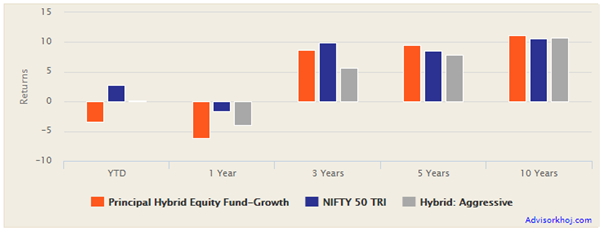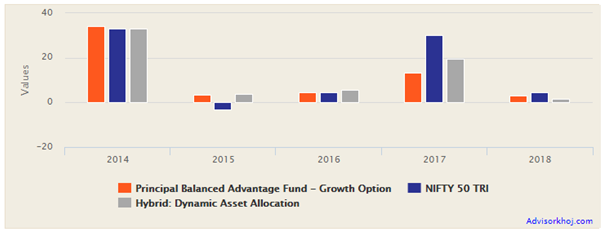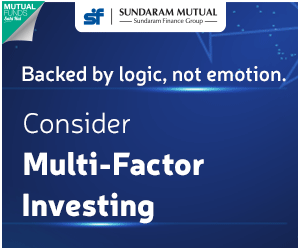Hybrid mutual funds for different investment needs: Principal MF Hybrid Schemes

We have stated a number of times in our blog that your fund selection should always be based on your investment goals and risk appetite, not on stock market conditions. The stock market moves up and down, but your financial goals do not change with market movement. Risk appetite should also be an important factor in your investment decision making. Different asset classes have different risk profiles. Suitable asset allocation is the most important success factor in achieving your financial goals.
Hybrid mutual funds, as the name suggests invests in equity and debt securities in different proportions, depending on the fund category. Asset allocation of these funds can range from high equity allocation (up to 80% of the scheme portfolio) to high debt allocation (up to 90% of the scheme portfolio) or arbitrage (risk free profits with completely hedged equity allocation). Accordingly these funds are suitable for wide range of risk appetites, from conservative to moderately aggressive, provided you select the right scheme according to your investment needs.
Over the last 5 years or so, hybrid mutual funds have become increasingly popular with retail investors. However, based on the queries and comments we received from different investors, it seems that many investors are confused about different types of hybrid mutual funds and how they can select the right fund for their investment needs. Fortunately, SEBI had laid out clear guidelines for different hybrid mutual fund categories, which can help you make informed investment decisions according to your needs.
In this blog post, we will discuss different types of hybrid mutual funds and highlight Principal Mutual Fund hybrid schemes.
Aggressive Hybrid Fund – Principal Hybrid Equity Fund
Aggressive Hybrid Funds invest 65 – 80% of their assets in equity and equity oriented securities and the balance in debt, money market securities and cash equivalents. As on 31st July 2019, Principal Hybrid Equity Fund had 72% allocation to equity, 18% allocation to debt and 10% in cash equivalents. The equity allocation of the scheme had a large cap bias (57% of the assets were invested in large cap stocks). The debt component comprises of high quality instruments (to minimize credit risks) with active duration management (for interest rate risk).
The chart below shows the performance of Principal Hybrid Equity Fund versus the aggressive hybrid funds category and Nifty over different trailing time-scales (returns over 1 year+ periods are annualized).

Source: Advisorkhoj Research
Though the scheme has underperformed in the last 1 year, the scheme has outperformed the category over longer horizons. You can also see that the scheme has beaten even the Nifty returns over 5 and 10 years period despite having 35% debt allocation making it less risky than Nifty. Principal Hybrid Equity Fund is one of the best performing aggressive hybrid funds over last 3 to 5 years (please see our Top Performing Mutual Funds (Trailing returns) - Hybrid: Aggressive).
Suitability: Aggressive hybrid funds, including Principal Hybrid Equity Fund are suitable for investors with moderately high risk appetite. Investors should have minimum 3 year investment horizon for these funds. In our view however, investors should be prepared to remain invested for 5 years or more to get the best results.
Suggested reading: The best hybrid aggressive fund in the last 3 years
Dynamic Asset Allocation Funds – Principal Balanced Advantage Fund
In these funds the equity and debt allocations are managed dynamically according to the scheme’s asset allocation model. Principal Balanced Advantage Fund increases equity allocation and decreases debt allocation correspondingly when equity valuations (PE ratio) are low and vice versa, according to fund house’s in-house asset allocation model. Currently, equity allocation of the scheme is around 67% with a large cap bias. The debt allocation is 11%, while 22% of the scheme assets are in cash equivalents.
The high cash allocation can enable the fund managers of the schemes manage asset allocation according to changing market conditions. The fund dynamically switches between equity and fixed income instruments at a predefined interval; thus, reducing market related risk.The fund invests based on a pre-defined rules based asset allocation model, which is based on month-end trailing Price to Earnings (PE) ratio of the Nifty 50. The chart below shows the annual performance of Principal Balanced Advantage Fund versus the dynamic asset allocation funds category and Nifty over last 5 years, across different market conditions. You can see that, Principal Balanced Advantage fund outperformed the category in difficult market conditions of 2018.

Source: Advisorkhoj Research
Suitability: Dynamic Asset Allocation Funds, including Principal Balanced Advantage Fund are suitable for investors with moderately high risk appetites, who prefer stable growth and low volatility. This fund is ideal for new investors who do not have investment experience in different market cycles. Dynamic Asset Allocation Funds are less volatile (risky) than Aggressive Hybrid Funds, but they tend to give lower returns than Aggressive Hybrid Funds over longer tenures. At the same time historical returns of these funds are usually higher than traditional fixed income returns over 3 years plus tenures on a post tax basis. Investors should have minimum three year tenures for these funds.
Suggested reading: How it is a good investment option in uncertain market conditions
Equity Savings Fund – Principal Equity Savings Fund
These funds invest in equity, debt and arbitrage. Minimum 65% gross equity allocation ensures equity taxation for these funds, but the net equity allocation is lower due to hedging. Hedging not only lowers the risk, it also enables the fund managers of the equity savings schemes to exploit price differences in cash and derivative segments of the market to generate arbitrage income (risk free profits).
Principal Equity Savings Fund invests 65 – 90% of its assets in equity and equity related securities, of which the net long exposure is only 20 – 35%; the balance equity exposure is hedged with derivatives. The scheme invests 40 – 70% of the assets in arbitrage opportunities (totally hedged) with no market risk. 10 – 35% of the scheme assets invest in debt and cash equivalents. The chart below shows the performance of Principal Equity Savings Fund versus the equity savings fund category and Nifty over different trailing time-scales (returns over 1 year+ periods are annualized).

Source: Advisorkhoj Research
You can see that the scheme has outperformed the category over the last 1 to 5 years. Principal Equity Savings Fund is among the top performing funds in its category over the last 1 to 3 years (Top Performing Mutual Funds (Trailing returns) - Hybrid: Equity Savings).
Suitability: Equity Savings Funds including Principal Equity Savings Fund are suitable for risk-averse investors who prefer low volatility and at the same time, are ready to take some amount of risk to get higher post tax returns than traditional fixed income investments. These funds are ideal for first time investors. Since maximum net equity exposure is only 35%, Principal Equity Savings Fund is less risky than dynamic asset allocation funds and aggressive hybrid funds; returns over long investment horizon are correspondingly lower.
From an asset allocation standpoint, equity savings funds are closer to conservative hybrid funds (debt oriented) where maximum equity allocation is 25%. However, equity savings fund enjoy equity taxation unlike conservative (debt oriented) hybrid funds which are subject to debt taxation. Investors should have minimum 3 year investment tenures for these funds.
Suggested reading: How Principal Equity Savings Fund can be a good choice for investors looking for regular income and capital appreciation
Arbitrage Funds - Principal Arbitrage Fund
These funds invest in arbitrage opportunities and debt / money market securities. The minimum gross equity exposure in arbitrage funds is 65% which ensures equity taxation for these schemes. The equity portfolio is completely hedged by taking offsetting positions in cash and derivatives market segments, thereby insulating these funds from equity market risks. These schemes generate risk-free profits by taking advantage of price differences of the same underlying asset in the cash market and futures market. For example if the futures price of a stock in the derivatives market is higher than the price in the cash market, the fund manager will lock in risk free profit by buying the stock in cash market and selling it in the futures market, irrespective of which direction the price moves (up or down).
Principal Arbitrage Fund maintains gross equity exposure between 65 to 90%. However, the equity exposure is completely (100%) hedged by taking offsetting positions in the derivatives (F&O) market. The fund invests 10 – 35% of its assets in debt and money market securities, depending on the arbitrage opportunities in the equity (cash and derivatives) market.
Suitability: Arbitrage funds are suitable for moderately conservative investors, who do not want to take equity market risk, want high liquidity and better post tax returns than savings bank interest rates. Principal Arbitrage Fund does not charge any exit load for redemptions after 30 days from the date of investment. Therefore, you can park the idle money in your savings bank account for a few months or more. Since this fund is treated as an equity fund from a taxation perspective, you can avail of long term capital gains tax benefits by investing in this fund for 1 year or longer periods depending on your investment needs. Long term capital gains (investment period of more than 12 months) of up to Rs 1 lakh per year is tax exempt; long term capital gains in excess of Rs 1 lakh is taxed at 10%. From a tax perspective these funds are more efficient than liquid funds and savings bank accounts, especially for investors in the higher tax brackets.
Taxation
All the 4 hybrid funds discussed in this post enjoy equity taxation. While fixed income investments for 3 years or less investment tenures are taxed as per the income tax rate of the investors, capital gains from these hybrid funds held for more than a year are tax free up to Rs 1 lakh. Long term capital gains (investment held for more than 12 months) in excess of Rs 1 lakh are taxed at 10%. If for any reason, you have to redeem your hybrid fund investments (in these 4 categories) within 1 year, capital gains made by you will be taxed at 15%. From a taxation viewpoint, these funds are among the most tax efficient investments.
Conclusion
In this blog post, we have discussed how hybrid mutual funds offer a range of investment solutions for different financial goals, investment tenures and risk appetites. You should always select the scheme which is suitable for your investment needs and not go for schemes which have given highest returns. If you are in doubt about which scheme is suitable for you, you should always consult with your financial advisor.
Mutual Fund Investments are subject to market risk, read all scheme related documents carefully.
Queries
-
What is the benefit of mutual fund STP
Aug 29, 2019
-
How much to invest to meet target amount of Rs 2 Crores
Aug 26, 2019
-
Can I achieve my financial goals with my current mutual fund investments
Aug 24, 2019
-
Can you tell me return of various indices
Aug 19, 2019
-
What would be the post tax return on different investments
Aug 18, 2019
-
Which Principal Mutual Fund scheme will be suitable for my retirement corpus
Aug 16, 2019
-
What is the minimum holding period for availing NCD interest
Aug 4, 2019
Top Performing Mutual Funds
Recommended Reading
Fund News
-
Motilal Oswal Mutual Fund launches Motilal Oswal Diversified Equity Flexicap Passive Fund of Funds
Jan 2, 2026 by Advisorkhoj Team
-
Mr. Navneet Munot's 'Person of the Year 2025'
Dec 31, 2025 by HDFC Mutual Fund
-
Zerodha Mutual Fund launches Zerodha Nifty Short Duration G Sec Index Fund
Dec 26, 2025 by Advisorkhoj Team
-
Groww Mutual Fund launches Groww Nifty Chemicals ETF
Dec 26, 2025 by Advisorkhoj Team
-
DSP Mutual Fund launches DSP Nifty Next 50 ETF
Dec 19, 2025 by Advisorkhoj Team














